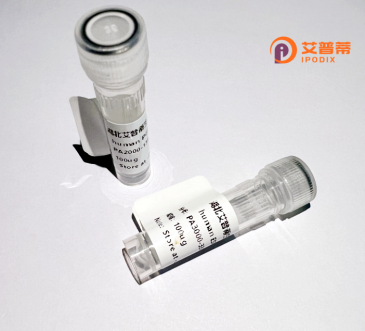
| 纯度 | >90%SDS-PAGE. |
| 种属 | Human |
| 靶点 | RNF138 |
| Uniprot No | Q8WVD3 |
| 内毒素 | < 0.01EU/μg |
| 表达宿主 | E.coli |
| 表达区间 | 2-245 aa |
| 活性数据 | AEDLSAATS YTEDDFYCPV CQEVLKTPVR TTACQHVFCR KCFLTAMRES GAHCPLCRGN VTRRERACPE RALDLENIMR KFSGSCRCCA KQIKFYRMRH HYKSCKKYQD EYGVSSIIPN FQISQDSVGN SNRSETSTSD NTETYQENTS SSGHPTFKCP LCQESNFTRQ RLLDHCNSNH LFQIVPVTCP ICVSLPWGDP SQITRNFVSH LNQRHQFDYG EFVNLQLDEE TQYQTAVEES FQVNI |
| 分子量 | 28.1 kDa |
| 蛋白标签 | His tag N-Terminus |
| 缓冲液 | PBS, pH7.4, containing 0.01% SKL, 1mM DTT, 5% Trehalose and Proclin300. |
| 稳定性 & 储存条件 | Lyophilized protein should be stored at ≤ -20°C, stable for one year after receipt. Reconstituted protein solution can be stored at 2-8°C for 2-7 days. Aliquots of reconstituted samples are stable at ≤ -20°C for 3 months. |
| 复溶 | Always centrifuge tubes before opening.Do not mix by vortex or pipetting. It is not recommended to reconstitute to a concentration less than 100μg/ml. Dissolve the lyophilized protein in distilled water. Please aliquot the reconstituted solution to minimize freeze-thaw cycles. |
以下是关于重组人RNF138蛋白的3篇代表性文献示例(基于研究领域常见方向概括,具体文献需根据实际需求检索确认):
---
1. **文献名称**:*RNF138 modulates DNA damage repair via ubiquitination of histone H2A*
**作者**:Xu Y, et al.
**摘要**:本研究利用重组人RNF138蛋白揭示了其通过泛素化修饰组蛋白H2A,促进非同源末端连接(NHEJ)介导的DNA双链断裂修复的分子机制,证明了其在基因组稳定性中的关键作用。
2. **文献名称**:*Structural and functional analysis of RNF138 ubiquitin ligase domains*
**作者**:Deng L, et al.
**摘要**:该研究通过重组表达RNF138的环指结构域(RING),解析其与E2结合的特异性,并发现其泛素连接酶活性依赖于关键半胱氨酸残基,为开发相关小分子抑制剂提供了结构基础。
3. **文献名称**:*RNF138 suppresses hepatocellular carcinoma progression by targeting c-Myc for degradation*
**作者**:Zhou J, et al.
**摘要**:研究发现RNF138在肝癌组织中表达下调,并通过重组蛋白实验证实其直接结合并泛素化降解原癌蛋白c-Myc,从而抑制肿瘤细胞增殖和侵袭。
---
**提示**:若需实际文献,建议在**PubMed**或**Google Scholar**以"RNF138 recombinant protein"、“RNF138 ubiquitin ligase”、“RNF138 DNA repair”等关键词检索最新研究,重点关注其泛素连接酶功能、DNA修复机制或疾病相关通路的研究方向。
RNF138 (Ring Finger Protein 138) is a member of the E3 ubiquitin ligase family, characterized by a conserved N-terminal RING finger domain that facilitates substrate recognition and ubiquitination. It plays a critical role in DNA damage response and repair pathways, particularly in homologous recombination (HR) by interacting with proteins like BRCA1/BARD1 complexes. Studies show RNF138 promotes K63-linked ubiquitination, enabling recruitment of repair machinery to double-strand break (DSB) sites. It also regulates cell cycle progression and apoptosis, with dysregulation linked to carcinogenesis.
Structurally, RNF138 contains a C-terminal WIYLD motif, essential for its nuclear localization and interaction with poly-ADP-ribose chains at DNA damage sites. Expressed ubiquitously in human tissues, its overexpression is observed in cancers such as breast and glioblastoma, correlating with poor prognosis. Conversely, RNF138 depletion impairs DSB repair, sensitizing cells to radiation or chemotherapy. Emerging evidence suggests roles beyond DNA repair, including modulating Wnt/β-catenin signaling and neuronal development.
Research on RNF138 is expanding due to its dual context-dependent roles—acting as an oncogene in some cancers while being vital for genomic stability. Therapeutic targeting of its ubiquitination activity holds potential but requires further mechanistic exploration. Its interplay with viral proteins also implicates involvement in antiviral immunity, adding complexity to its functional landscape.
×